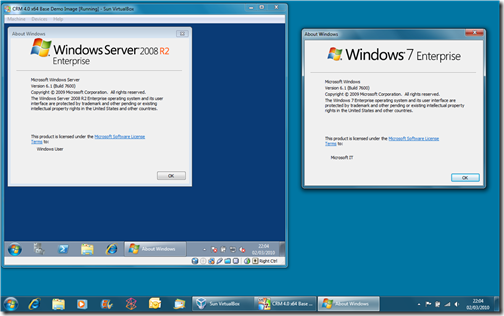Making The Move to 64-bit Demos
Do Ya…
This week Alexander “Monty” Montgomery (not the famous Jazz pianist Monty Alexander) joined my team, replacing Craig Steere (a former South African) who decided he wanted good weather back in his life and is now working for Microsoft in Australia. As I mentioned previously, there are three of us in the UK Dynamics CRM pre-sales team; I cover the Financial Services sector, Michael Wignall covers Public Sector and now Monty picks up pretty much everything else (Retail, Professional Services, Manufacturing, Media, Legal etc.).
Monty’s first job was to completely remove the corporate build of Windows 7 from his laptop (a shiny, almost-new HP EliteBook 8530w with 8GB RAM) and install Windows Server 2008 R2 with Hyper-V to use as his main demo PC. Now call me old fashioned, but I like the creature comforts of Windows 7 (particularly Direct Access), and have avoided using our server products as a desktop OS. However, the pressure to move to 64-bit virtual demo environments is increasing rapidly, with Windows Server 2008 R2 and Exchange Server 2010 only available in 64-bit editions and soon-to-be-released SharePoint Server 2010 and SQL Server 2008 R2 following suit later this year.
It looked like there was no alternative but to join Monty in Hyper-V heaven, since our desktop virtualisation products (Microsoft Virtual PC 2007 and its successor, Windows 7 Virtual PC) only support 32-bit guest operating systems. However, I just discovered another product which seems to meet my requirements and is free of charge for personal use. BUT, and this is a biggie, the product is developed and distributed (albeit under the GNU GPL v2 license) by Sun, who are now owned by Oracle. Ouch.!!
VirtualBox has some really compelling capabilities as a desktop virtualisation solution, including:
- Guest support for both 32-bit and 64-bit operating systems
- Guest support for pretty much every version of Windows since Windows 3.1 right up to Windows 7 and Windows Server 2008
- Guest support for multi-processors/multi-cores (unlike Virtual PC which only makes use of a single processor/core even on a multi-processor/multi-core system)
- Guest support for more than 3.7GB RAM (a limit of the Virtual PC 32-bit architecture)
- Support for .VHD image file format. Although you cannot create a .VHD file natively, you can use your existing Virtual PC & Hyper-V images and run them on VirtualBox.
I have been evaluation this product for a couple of days now, and have built a 64-bit virtual test environment with Windows Server 2008 R2, SQL Server 2008, CRM 4.0, Exchange Server 2010 and SharePoint Server 2007, and I have to say I am really impressed so far. I have noticed a reasonable performance improvement over Virtual PC 2007, primarily because of the multi-core support and being able to assign more than 3.7GB RAM. Stability too seems to be fine.
So do I feel slightly “dirty” using a competitor’s product? Yes. Is the combination of Windows 7 plus VirtualBox compelling enough for me to overcome my natural inclinations? Only time will tell, but so-far-so-good. Will I switch if Microsoft brings out a future version of Virtual PC that supports 64-bit? You bet.!!!
This posting is provided "AS IS" with no warranties, and confers no rights.
Laughing Boy Chestnuts Pre-School
Comments
- Anonymous
March 14, 2010
The comment has been removed
